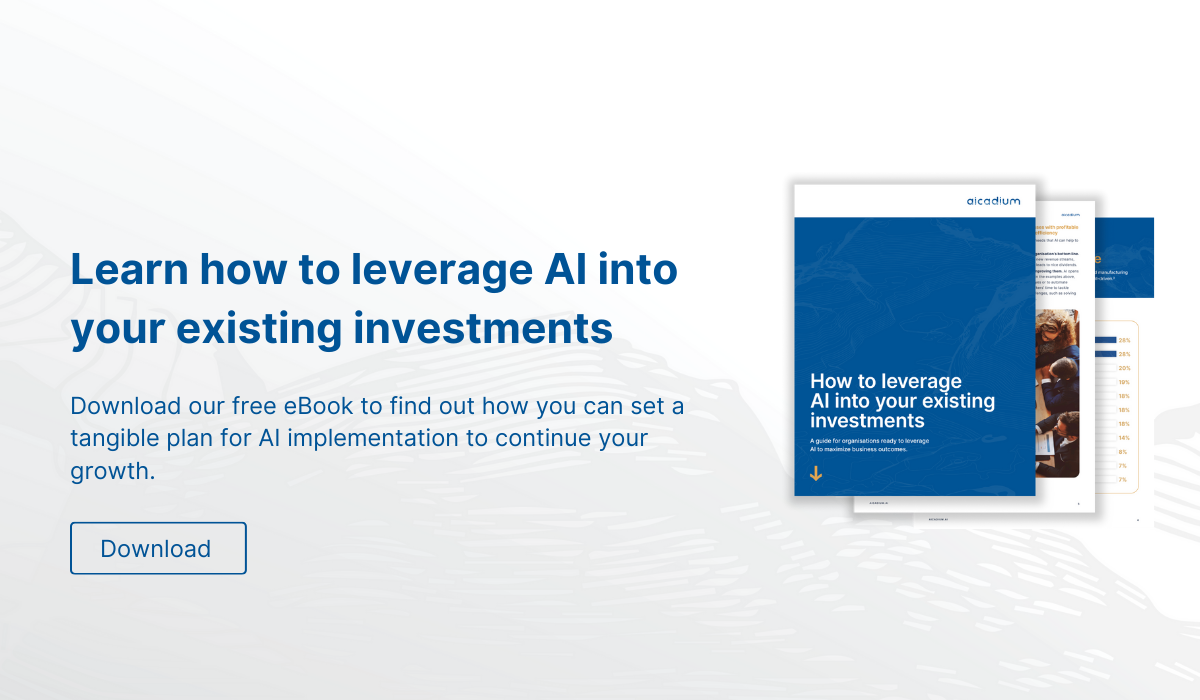In the first two parts of our series, we laid the groundwork for your AI journey by identifying opportunities and understanding the crucial role of an internal AI champion. Now, it’s time to dive into the heart of AI implementation—determining the right use case for your business. In this blog, we’ll guide you through a detailed process of evaluating potential projects, considering their value and impact on your organisation.
We’ll also provide insight into developing a set of key questions to rank and prioritize use cases for both short-term and long-term benefits.
Selecting the Right Use Case
Selecting the right AI use case is the compass that will guide your organisation toward successful AI integration. Here are three steps you can take to leverage AI effectively for your business:
Identify Suitable Technologies: It’s important to understand the different AI technologies and their suitability for specific tasks. The first step categorises AI into three key areas: process automation, cognitive insight, and cognitive engagement. Each type has its strengths and weaknesses, and understanding these distinctions is crucial. Begin by categorising your organisation’s problem types. For example, is your use case centred around improving person-to-person engagement, or is it more about addressing data challenges? Cognitive engagement may be the answer for the former, while cognitive insight could be the solution.
Establish a Project List Based on Business Requirements: The next step involves aligning your AI initiatives with your organisation’s unique business requirements. Keep in mind that these requirements can vary from one industry to another. What’s suitable for solving problems in the automotive industry might not work for the financial sector. For instance, rule-based expert systems and robotic process automation are transparent in their operations but cannot learn and adapt. On the other hand, deep learning excels in learning from vast amounts of labelled data. Still, it can be seen as a “black box” in heavily regulated industries like finance, where transparency is essential.
Strategies for Scaling AI: To ensure organisational success, it’s essential to have a detailed plan for achieving your goals, scaling up AI adoption, and implementing automation effectively. Collaboration between technology experts and process owners is crucial. Integrating cognitive technologies with existing systems and processes is also a key step. Scaling up with these technologies requires addressing specific limitations, so discussing scaling considerations with IT leaders is critical, either before or during the pilot phase.
Measuring the Value of Your Use Cases
Now that you have identified your use cases, defining the metrics and key performance indicators (KPIs) that will help assess its impact is essential. This proactive approach ensures that your organisation reaps the full benefits of AI implementation and justifies the investment in AI projects.
Assessing Potential Value
Estimating the potential value of your AI initiatives before project initiation is crucial. Where can AI help you reduce costs or increase revenue? This step helps you set realistic expectations and align your projects with organisational goals. By estimating value upfront, you can ensure that your investments in AI projects are well-justified.
Measuring Actual Value
Once your AI initiatives are implemented, measuring their actual value is equally critical. It provides the empirical data to validate your assumptions and realise the expected benefits. Measuring the actual value of your AI projects is not just about the direct impact; it also uncovers indirect advantages that may have been initially overlooked.
Value Uplift Possibilities
AI projects have the potential to deliver value uplift in various ways:
-
Cost Savings
AI can reduce rework costs with the same resources or help reduce resources while maintaining the same rework costs.
-
Increased Productivity
AI can boost productivity by automating repetitive tasks, streamlining processes, and optimizing resource allocation. This enables teams to accomplish more with current resources. For instance, combined with robotic process automation, small teams can utilise generative AI and computer vision technologies to accomplish more with fewer resources. Increasing efficiency and productivity gains.
-
New Products and Services
Emerging technologies, such as large language models, empower organizations to develop new solutions that cater to evolving market demands. AI opens up opportunities to create new products and services in previously infeasible areas. This broadens the product and service portfolio and opens up new revenue streams.
-
Improved Quality
Automated defect recognition, for instance, reduces errors in manufacturing and production processes. This saves costs associated with rework and results in a better-quality end product. In industries where precision and quality are paramount, such as electronic device assembly or industrial food preparation, AI-powered technologies can help workers make fewer errors.
-
Faster Decision-Making
AI can expedite the decision-making processes, enhancing operational efficiency, agility, and competitiveness. AI allows organisations to adapt swiftly to evolving market dynamics, seize emerging opportunities, and address risks for improved performance and increased value. In an ever-evolving business landscape, making informed decisions swiftly is a significant advantage.
Indirect benefits of AI can be equally significant, including:
-
Enhancing Customer Satisfaction
As you reduce error rates and rework costs, customers will notice an improved quality of your products and services. This heightened quality can result in enhanced customer satisfaction and an improved reputation for your company.
-
Attracting New Talent
In today’s competitive job market, businesses that invest in emerging technologies like AI have a secondary benefit – they become more attractive to potential talent. Skilled professionals are drawn to organisations committed to innovation and career growth. This can aid in attracting and retaining top talent, which is critical for a company’s long-term success.
Evaluating Use Cases – A checklist
Now that you have diligently measured the value of your use cases, uncovering the significant value uplift possibilities they hold, it’s time to embark on the next crucial phase of your AI journey: the evaluation process. Armed with valuable insights into the potential benefits of each use case, you are well-prepared to make informed decisions regarding their prioritization and implementation. This evaluation stage will guide you in selecting your organisation’s most strategic and impactful AI initiatives, aligning them with your broader business objectives, and ensuring that your AI investment is meaningful and future-focused.
To do this effectively, you need to ask a set of key questions. Here are some essential questions to guide you through the assessment process:
Does it Solve a Real Problem?
a. Is the use case addressing a genuine problem or need within your organisation? The value of AI becomes apparent when it solves real challenges.
b. Will the use case streamline processes, save time, or enhance productivity within your organisation? Efficiency gains are often a significant driver for AI adoption.
Does your business possess the necessary data to train and support the AI model for this use case? The quality and quantity of data are critical for AI success.
a. If you don’t have the data, is it possible to generate or purchase it?
b. Is the data sensitive or proprietary? Does it need to stay on the premises?
Does it Align with Your Business Goals?
a. Is the use case aligned with your overall business strategy and objectives? AI projects should contribute to your long-term success.
Is it Scalable?
a. Can the use case be scaled as your business grows? Scalability is crucial to ensuring long-term value from your AI investments.
What’s the Potential ROI?
a. Assess the potential return on investment for the use case. How will it impact your bottom line?
Is it Ethical and Compliant?
a. Ensure that the use case adheres to legal guidelines and regulations. Is there personal data needed to build your AI solutions? How will it be stored, and who can access it?
b. Ethical considerations are increasingly vital in AI development. Can you avoid unethical bias with your AI-based solution?
Determining the right use case for your business is a pivotal step in your AI journey. It involves carefully considering, assessing, and prioritising potential projects to ensure that the AI software aligns with your business goals and maximises value. Remember, your internal AI champion and a cross-functional team can help you make informed decisions and set your organisation on the path to success in the era of artificial intelligence.
After you and your team have explored the critical aspects of selecting the perfect AI use case, it’s time to implement this knowledge and drive your business forward.
Download our eBook, “How to Leverage AI into Your Existing Investments,” is the essential resource you need to embark on your AI journey.
Learn how you can:
- Leverage AI and accelerate your organisation’s growth
- Prioritise AI integrations according to your organisation’s budget
- Utilise AI integrations to improve your customer relationships
Stay tuned for the next part of our series, where we’ll dive into the crucial aspects of AI project planning and implementation.






